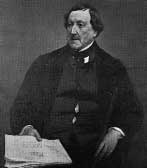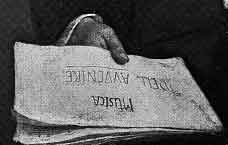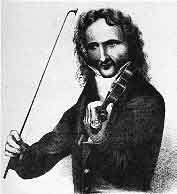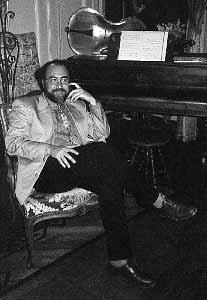The Wisdom of Apollo
 «True beauty is SAPIENTIA»
«True beauty is SAPIENTIA»
Leone Ebreo
«All that which is beautiful is light»
Nietzsche

claudio ronco
In a famous portrait by Francesco Hayez,
Gioacchino Rossini is shown no longer young, sprawled in a chair,
his gaze distant and inscrutable, his right hand on a half-open
score laid across his knees; on it we read in enormous letters
"MUSICA DELL'AVVENIRE",

(Music of the Future) the last
word underlined almost as though to shroud in uneasiness the
question: Who is the author of the music in that score? Was the
"future" in question the Zukunft of Wagner,
who had theorized it for the world in his 1848 book "The
Work of Art of the Future"? Or was it the sublimated essence
of Rossini's musical thought, projecred prophetically into a
possible or probable future, in which the out put of Italian
musicians could regain the authority it commanded in Corelli's
time? In fact, for almost two centuries the "language,"
the rhetoric, of musical expression had been constituted in the
sweet mellifluousness of the Italian tongue, bot now, in the
nineteenth century, the archetype was the sublime of the
visionary processes of German art. And Italy seemed to quail
before it, to fear the unknown, or rather that which seemed to
attract the Nordic mind.
From this springs the dissatisfaction
of modern interpreters who compare the works of the great German
classical composers with those of Paganini, Bellini or Donizetti.
Wherever vocality is the model of beauty and technique (even
violin technique), we rejoice in the richness and efficacy of
Italian music. But faced with the poetic itinerary and dramatic
greatness of northern compositions, we often end up concluding
that the Italians had little or no authentic sense of the tragic,
and that their music was only rhetoric (in the negative sense)
or hedonism, mere drawing-room entertainment. Only in the Opera
does everything still seem to find a balance and a persuasive
force, in a style born of an extraordinary naturalness in vocal
and instrumental technique.
This is the heart of the issue: the Italian
cellist or violinist will always be preferred for the beauty
of the way in which sound is drawn from the instrument, the so
called cavata, the "penetrative" quality of
that sound, its perfect fusion with the singers; others - Belgians,
Germans, the French - will be judged more brilliant in imitating
violin feats on the cello or in inventing new ones for the violin,
or more capable of mastering the contrapuntal complexities of
the chamber music of the great romantic composers. But no one
is remembered for melodiousness or for the beauty of their sound
as the Italians are. Thus even among violinists Paganini is as
much loved as he is hated by his contemporaries, as if he indeed
had to carry on his shoulders the weight of the entire Italian
baroque tradition, where the violin school - and the violinmaking
of the Cremona masters - were the matrix or the model upon which
all of musical Europe was based.

These were the arguments made repeatedly
for over half a century by all Italian composers and virtuosos,
in secking an explanation for the haughty disdain in which they
were often held, particularly by the Germans.
To better understand this reality we must
explore why the three Duetti concertanti for violin and
cello, composed in Varese in 1824 by Alessandro Rolla, could
very well have been conceived already in 1790, since little more
is discernible in them than the Corellian model applied to the
new style which Franz Joseph Haydn introduced with the famous
Quartets Op. 20, and to Bel canto melody. We must
also explore why the three Duetti concertanti by Nicolò
Paganini, composed at least ten years earlier, could be imagined
in any post-Classical period.
What in fact is missing in the music of
the Italian contemporaries of Beethoven? I find that we never
encounter the uneasiness of an oneiric imagery, or the desire
to plunge into the unknown regions of the mind. Mythology - beyond
that of Arcadia - does not seem a part of their musical language.
What is it then that generates "energy" in that language?
Perhaps the sensuality derived from a precise adherence to the
immediacy of the real, to nature as it is perceived by the body
taut with desire for erotic contact, harmonious contact, with
visible and tangible things. In this "triumph of the senses"
it would seem all the more possible to speak of an Italian musical
"eroticism". In fact the mind need not wander far to
gather the suggestions of this music: on the contrary, it must
remain attached to sound as to a body with which it must move,
must gather sudden sensations and immediate physical reactions
to musical effects. Thus the irrational is banished in a certain
sense insofar as it could induce casual reactions, difficult
to evoke by a programmatic rhetoric.
While the Germans were trying to represent
the "sublime" in the majestic phenomena of nature,
- those which inspire terror, or in the fantastic visions of
the unconscious, a region which was then yet to be explored -
for Paganini the expression of uneasiness can still be merely
a Capriccio: a whim. Here it is an ideally, perfectly
baroque Capriccio, where the heroic gesture is not that of the
great heroes of mythology, but only that of a man who, on his
artfully crafted wooden instrument, transcends the "weight"
of things and of the concrete. Inebriated with freedom he flings
himself into infinite space, secured by that "umbilical
cord" which holds him firmly to a fixed point in the universe
of sound: the tonality, the melodious framework, the technique
of his instrument.
In Rolla's duets, for example, the cello is used even in the
extreme high notes with brilliant technique, yet never departing
from the rationality of the form and nature of the instrument.
Rolla's inventions are thus simple and magnificent, polished
to create accompaniments of great polyphonic effect; and all
the richness of sound he can produce seems to be motivated solely
by the pleasure of contemplating itself. The themes in fact are
quite conventional, as though they need be nothing but mere pretexts
for the creation of the greatest beauty of sound and of ensemble.
Indeed everything is light, as if suspended in the network of
a structure which is itself solid and reassuring, so that every
emotion is expressed solely through virtuosity: from the fingers
and from the bow, and from the ideas which these know how to
soggest: emphasizing phrases with a variety of accents, attributing
various timbres to various melodies, and thus succeeding in transforming
musical suggestions ad infinitum thanks precisely to the
simplicity, or rather the Apollonean rationality, of the ideas
expounded and of their form.
Both in Rolla and in these Paganini pieces,
the care taken to "Italianize" their melodic phrase
is revealed in the "luminous" expansiveness of the
melody. The expression of melancholy always seems to be realized
by sweetening the phrase to the point of yielding a sense of
lack. The composition remains "energetic" as long as
it continues to maintain itself within the strict dialogue among
the two Concertante instruments, and every relaxation
of the phrase is the site at which attention is arrested by the
other: the one which before was accompaniment, now allowed with
loving complicity to dominate.
Thus this music seems to create an infinite game of love, that
of building an amorous relationship: giving, denying,
whispering, expanding. It all seems a search for vital impulses
that do not want to -and therefore cannot- oppose or contradict
nature. That is then why their formal schema is of necessity
simple, or "classical," and can only with difficulty
be imagined as rivolutionary or unsettling: the form must be
in some way reassuring, definite, immutable. The composition
thus becomes an exercise in civility, which explores a nature
conditioned by the equilibrium acquired by rational thonght;
it explores the best reactions to the stimuli of life, and the
performance, or its reception, becomes an exercise in the art
of living. The beginning and the ending of this music seem in
fact to be the most delicate elements in its performance: it
is there that we must create the conditions for a "pleasure"
which is not only an image of "beauty", but also the
immersion into an emotive experience strictly linked to the logic
of form and of harmony defined by classical academicism, by the
School, as a "second nature " It is thus that for a
musician such as Rolla, to play signifies an exercise of love,
just as it was in Renaissance neoplatonic schools; here, as in
those schools, one could believe that whoever loves beauty therefore
also loves -even if he does not know it- knowledge, wisdom; briefly:
the SAPIENTIA.
Perhaps it was Paganini himself who destabilized
all of this, with his musical philosophy which was a sublime
desire for freedom, possessed in the heroic gesture of extreme
virtuosity. In him all beauty is derived from lightness, from
the ineffable beauty of the "body" and nature of the
sound of his music. Everything is suspended toward the irrational,
and lives and maintains itself only by the reflection of the
natural, which it yet desires - or loves - to flee.
One thing seems certain: Paganini could
be all that he was, because his "umbilical cords" were
Rolla, Veracini, Corelli, or in the final analysis Apollo himself,
who dominates and balances the Dionysian revels. Therefore if
the Music of the Future is to communicate the desire for
a higher order, that order could be a repossession of Rhetoric,
which, imposing on us its limits, gives us the courage to explore
what is unknown to us.

N. Paganini (1782-1840): lithograph
(c1820) by Karl Begas.
Thus we set about performing these two
collections of Duetti concertanti on instruments suited
for playing Italian composers from the mid-eighteenth century,
recalling that Paganini's contemporaries described the strangeness
of his "bow of antique design" and of his choice of
strings. Above all we thought that the specific risk of playing
on instruments built 50 years before this music was written,
might be our response to the heroic gesture of our virtuoso composers.
We have performed their works intending to represent them as
a meeting between two musician friends, in the improvisation
of reading, in building a sense one fragment at a time, secking
out the surprise of the unexpected or of melodic phrases prolonged
beyond expectation, as though intended to lure us into an irresistible
current of musical ideas. We ended up convinced that these two
collections of Duetti - never published, intended apparently
only for a limited circulation among "music lovers",
who in that period might also have been virtuosos - are in fact
an important lesson for those who seek a deeper understanding
of Paganini's technique and style, which has so far been offered
in too rigid and aggressive a manner to be able to recover the
immense variety of sounds, the transparency and the lightness
which we would like to attribute to it.
We invite to follow the itinerary of our
collective improvisational instincts, which led us to explore
all the musical ideas realizable on period instruments, in the
firm conviction that they too can contribute to the Music
of the Future.
Claudio Ronco, Venice,
august 1995

back
to the top